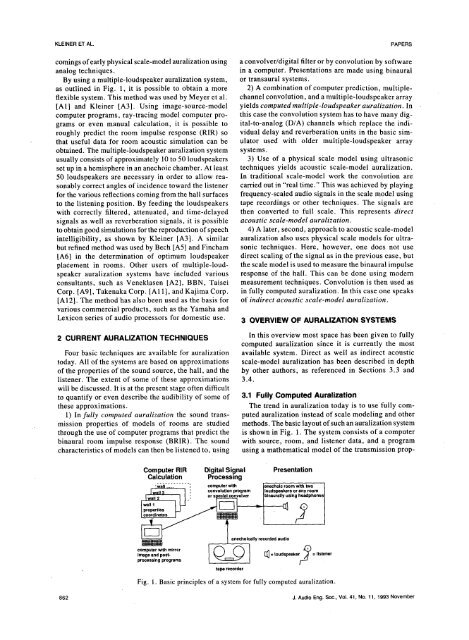Auralization An Overview* - Matt Montag
Auralization An Overview* - Matt Montag
Auralization An Overview* - Matt Montag
You also want an ePaper? Increase the reach of your titles
YUMPU automatically turns print PDFs into web optimized ePapers that Google loves.
KLEINER ET AL. PAPERS<br />
comings of early physical scale-model auralization using a convolver/digital filter or by convolution by software<br />
analog techniques, in a computer. Presentations are made using binaural<br />
By using a multiple-loudspeaker auralization system, or transaural systems.<br />
as outlined in Fig. 1, it is possible to obtain a more 2) A combination of computer prediction, multipleflexible<br />
system. This method was used by Meyer et al. channel convolution, and a multiple-loudspeaker array<br />
[Ali and Kleiner lA3]. Using image-source-model yields computedmultiple-loudspeakerauralization. In<br />
computer programs, ray-tracing model computer pro- this case the convolution system has to have many diggrams<br />
or even manual calculation, it is possible to ital-to-analog (D/A)channels which replace the indiroughly<br />
predict the room impulse response (RIR) so vidual delay and reverberation units in the basic simthat<br />
useful data for room acoustic simulation can be ulator used with older multiple-loudspeaker array<br />
obtained. The multiple-loudspeaker auralization system systems.<br />
usually consists of approximately 10 to 50 loudspeakers 3) Use of a physical scale model using ultrasonic<br />
set up in a hemisphere in an anechoic chamber. At least techniques yields acoustic scale-model auralization.<br />
50 loudspeakers are necessary in order to allow rea- In traditional scale-model work the convolution are<br />
sonably correct angles of incidence toward the listener carried out in "real time." This was achieved by playing<br />
for the various reflections coming from the hall surfaces frequency-scaled audio signals in the scale model using<br />
to the listening position. By feeding the loudspeakers tape recordings or other techniques. The signals are<br />
with correctly filtered, attenuated, and time-delayed then converted to full scale. This represents direct<br />
signals as well as reverberation signals, it is possible acoustic scale-model auralization.<br />
to obtain good simulations for the reproduction of speech 4) A later, second, approach to acoustic scale-model<br />
intelligibility, as shown by Kleiner lA3]. A similar auralization also uses physical scale models for ultrabut<br />
refined method was used by Bech lA5] and Fincham sonic techniques. Here, however, one does not use<br />
lA6] in the determination of optimum loudspeaker direct scaling of the signal as in the previous case, but<br />
placement in rooms. Other users of multiple-loud- the scale model is used to measure the binaural impulse<br />
speaker auralization systems have included various response of the hall. This can be done using modern<br />
consultants, such as Veneklasen lA2], BBN, Taisei measurement techniques. Convolution is then used as<br />
Corp. lag], Takenaka Corp. IAI 1], and Kajima Corp. in fully computed auralization. In this case one speaks<br />
[AI2]. The method has also been used as the basis for of indirect acoustic scale-model auralization.<br />
various commercial products, such as the Yamaha and<br />
Lexicon series of audio processors for domestic use. 3 OVERVIEW OF AURALIZATION SYSTEMS<br />
2 CURRENT AURALIZATION TECHNIQUES In this overview most space has been given to fully<br />
Computed auralization since it is currently the most<br />
Four basic techniques are available for auralization available system. Direct as well as indirect acoustic<br />
today. All of the systems are based on approximations scale-model auralization has been described in depth<br />
of the properties of the sound source, the hall, and the by other authors, as referenced in Sections 3.3 and<br />
listener. The extent of some of these approximations 3.4.<br />
will be discussed. It is at the present stage often difficult<br />
to quantify or even describe the audibility of some of 3.1 Fully Computed <strong>Auralization</strong><br />
these approximations. The trend in auralization today is to use fully cum-<br />
1) In fully computed auralization the sound trans- puted auralization instead of scale modeling and other<br />
mission properties of models of rooms are studied methods. The basic layout of such an auralization system<br />
through the use of computer programs that predict the is shown in Fig. 1. The system consists of a computer<br />
binaural room impulse response (BRIR). The sound with source, room, and listener data, and a program<br />
characteristics of models can then be listened to, using using a mathematical model of the transmission prop-<br />
Computer RIR Digital Signal Presentation<br />
Calculation Processing<br />
] Wallwa_ I''-'"'' ''' i ':: c°°nmvP°l_ir°wl Plttr°gram ,lanud%hl_-_l_e°r°m° rWan%r%O°m<br />
I wall 2 I [ ' or S I__..a__volver ,binaurally using headphone._<br />
I Pl__e_Tan[echolca,ly ;IrOIC<br />
recorded a:<br />
Image and post- [_ = loudspeaker = listener<br />
computer processingwith programs mirror I _.._ I /- _)<br />
tape recorder<br />
Fig. 1. Basic principles of a system for fully computed aaralization.<br />
862 J. Audio Eng. Soc., Vol. 41, No. 11, 1993 November


